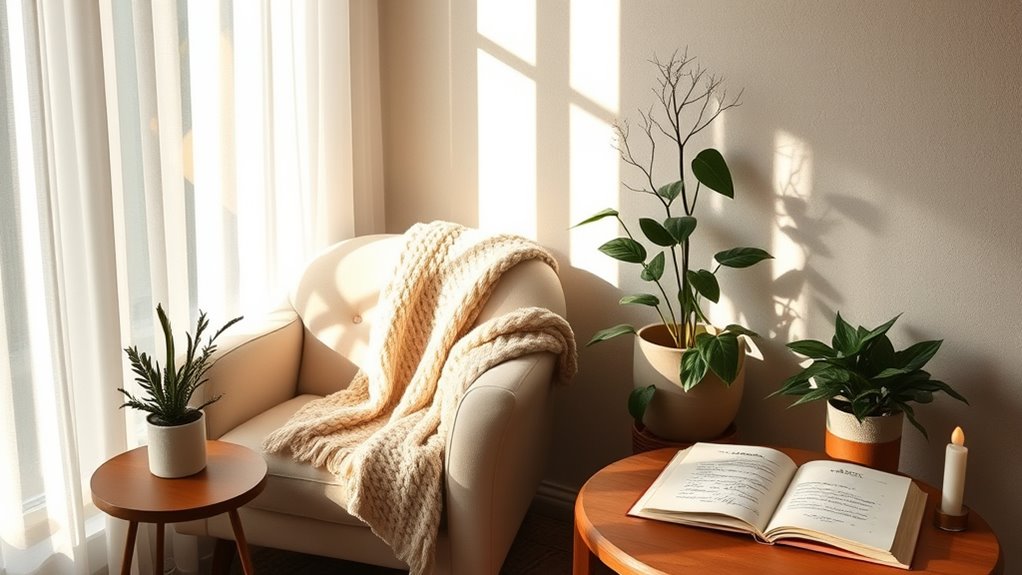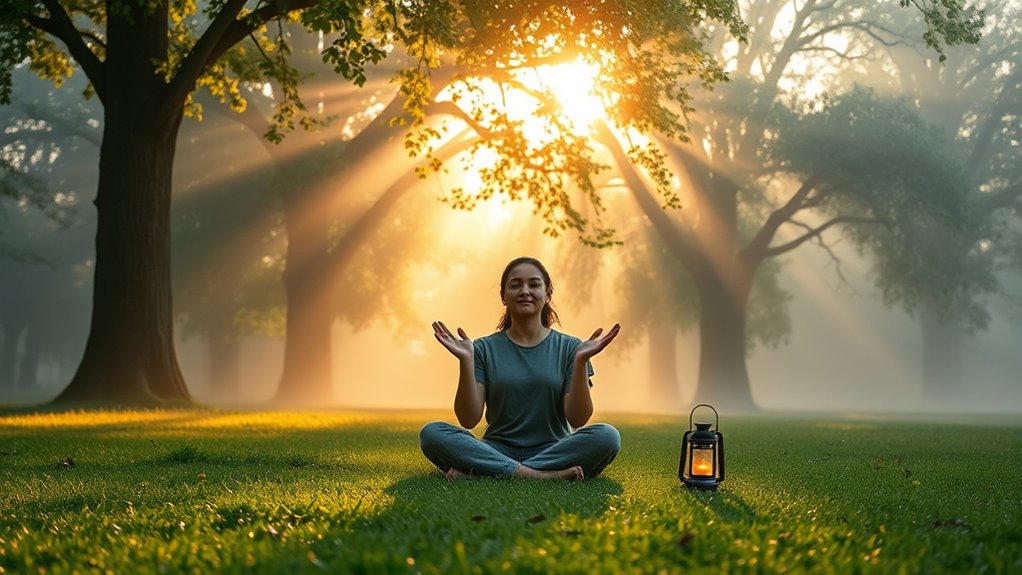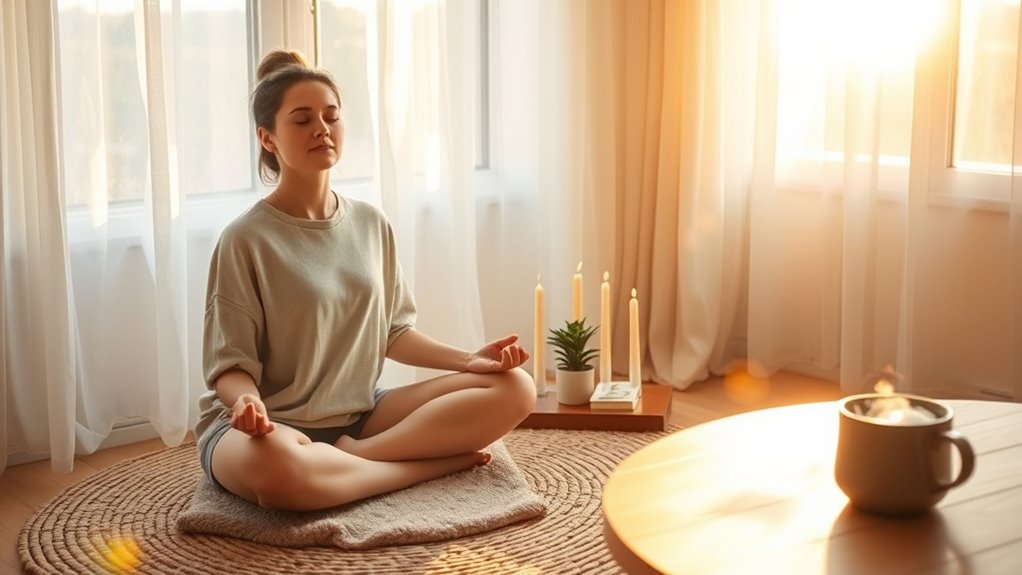To do a guided gratitude practice for loneliness, create a calm space with soothing music, soft lighting, and comforting textures. Focus on your breath, visualize a peaceful place, and reflect on your personal strengths and joyful moments. Practice gratitude daily by noticing small joys, and incorporate mindfulness through deep breathing and sensory awareness. By regularly nurturing these habits, you’ll build emotional resilience and connection. If you continue exploring, you’ll discover more ways to deepen your practice and boost your well-being.
Key Takeaways
- Create a calm, sensory-rich environment to foster presence and emotional grounding during gratitude practice.
- Visualize a safe space and reflect on personal strengths to cultivate inner peace and resilience.
- Focus on small joys and use mindfulness techniques like breathing exercises to deepen appreciation.
- Maintain regular gratitude routines, journaling, and reflection to enhance emotional stability and connection.
- Incorporate supportive activities such as gratitude circles and limit negativity to strengthen resilience against loneliness.
Understanding the Power of Gratitude in Solitude

Even when you’re alone, practicing gratitude can profoundly shift your perspective and deepen your sense of well-being. It helps build emotional resilience, allowing you to better handle life’s challenges. When you focus on what you’re grateful for, you cultivate self-compassion, giving yourself kindness and understanding during tough times. This mindset encourages you to recognize your strengths and appreciate small moments, fostering a positive outlook. Gratitude in solitude reminds you that happiness isn’t dependent on others; it’s an internal resource you can nurture. Over time, this practice strengthens your ability to stay grounded, even amid loneliness. By intentionally acknowledging what you value, you reinforce your emotional resilience and develop a compassionate relationship with yourself, making solitude a space for growth rather than despair. Additionally, engaging in activities like guided gratitude practices can help you cultivate a positive mindset that supports emotional well-being.
Setting Up a Calm and Comfortable Space

Creating a calm and comfortable space is an essential step in cultivating a meaningful gratitude practice. Begin by selecting a quiet area where you won’t be disturbed. Use decorative candles to add a gentle glow that fosters warmth and relaxation. Light the candles to create a peaceful ambiance, helping your mind settle. Play soothing music softly in the background, enhancing the tranquil environment. Keep the space tidy and free of distractions, so you can focus fully on your gratitude practice. Consider adding cozy cushions or a soft blanket to make the area inviting. This intentional setup signals to your body and mind that it’s time to slow down and reflect. When your surroundings feel calming and safe, it becomes easier to connect with feelings of gratitude. Incorporating elements like a dedicated space for reflection can further support your practice and reinforce your commitment to cultivating gratitude.
Guided Visualization: Connecting With Your Inner Self

To deepen your gratitude practice, guided visualization helps you connect with your inner self more authentically. As you close your eyes, imagine a safe space where you feel completely at ease. Focus on your breath and let your awareness drift inward. This process encourages self-discovery, allowing you to explore your true feelings and thoughts without judgment. Through this connection, you strengthen your emotional resilience, making it easier to cope with loneliness and challenges. Visualize yourself embracing your authentic self, recognizing your inner strengths and qualities. Regularly practicing this visualization builds a deeper understanding of who you are, fostering inner peace and a genuine sense of gratitude for your unique journey. Ensuring a safe environment during this practice aligns with newborn safety guidelines, promoting comfort and security in your inner exploration.
Focusing on Personal Strengths and Achievements

Take a moment to recognize your personal milestones and the progress you’ve made. Celebrate the qualities that make you unique and valuable. Focusing on these strengths can deepen your sense of gratitude and self-appreciation. Incorporating healthy habits like fiber intake can also support your overall well-being and resilience.
Recognize Personal Milestones
Recognizing your personal milestones helps you appreciate the progress you’ve made and the strengths you’ve developed along the way. Each achievement, no matter how small, reflects your personal growth and builds emotional resilience. By acknowledging these moments, you reinforce your sense of capability and remind yourself of the challenges you’ve overcome. Take a moment to reflect on key milestones—completing a project, making a difficult decision, or simply showing up when it was tough. These successes highlight your resilience and growth, strengthening your confidence. Celebrating personal milestones shifts your focus from loneliness to your journey of self-improvement. It reminds you that you are capable, evolving, and deserving of gratitude for your ongoing efforts. Paying attention to your personal finance stability can further reinforce your sense of achievement and control.
Celebrate Unique Qualities
Celebrating your unique qualities allows you to see the distinct strengths and achievements that set you apart. Recognizing what makes you different fosters self compassion exercises and deepens your appreciation for celebrating individuality. Take time to reflect on your personal strengths, such as kindness, resilience, or creativity. Acknowledge your achievements, big or small, with pride. Practicing gratitude for your unique qualities helps combat feelings of loneliness by reinforcing your value. Additionally, embracing limits can inspire you to discover new aspects of your personality and foster resilience in your creative practice.
Cultivating Appreciation for Small Joys

Even in busy or stressful moments, you can find small joys that brighten your day. Recognize these moments to nurture self-compassion, understanding that appreciating simple pleasures helps you build emotional resilience. Perhaps it’s a warm cup of coffee, a kind note, or a moment of quiet laughter. By intentionally noticing these small delights, you shift your focus away from loneliness and toward gratitude. This practice strengthens your ability to find happiness in everyday life, even during hard times. Cultivating appreciation for small joys doesn’t require grand gestures—just awareness and acceptance. Paying attention to positive visual cues like vibrant colors or bright lighting can enhance your mood and reinforce feelings of gratitude. Over time, this simple habit can deepen your connection to yourself, fostering kindness and resilience that carry you through moments of loneliness with greater ease.
Incorporating Mindfulness to Deepen the Practice

To deepen your gratitude practice, try incorporating mindfulness through focused breathing and sensory awareness exercises. These techniques help you stay present and fully experience moments of appreciation. Reflecting mindfully on your gratitude can strengthen your connection to the positive feelings you cultivate. Incorporating goal setting techniques can also enhance your ability to recognize progress and foster a sense of achievement in your journey.
Focused Breathing Techniques
Have you ever noticed how focusing on your breath can anchor you in the present moment? Using focused breathing techniques helps deepen your mindfulness and enhance mental focus. By paying close attention to each inhale and exhale, you reduce mental clutter and cultivate calmness. To strengthen this practice, try:
- Slow, deep breaths to promote relaxation
- Counting breaths to maintain concentration
- Noticing sensations in your body as you breathe
These techniques help you stay present, making your gratitude practice more effective. When your mind drifts, gently redirect your focus back to your breath. This simple act sharpens your awareness and creates a sense of stability, even amidst loneliness. Focused breathing becomes a tool to ground yourself and foster inner peace. Incorporating mindfulness into your routine can also amplify these benefits and support overall well-being.
Sensory Awareness Exercises
Building on your focus on breathing, incorporating sensory awareness exercises can deepen your mindfulness practice. By paying close attention to what you see, hear, feel, taste, and smell, you strengthen your sensory awareness and create a sense of emotional grounding. Focus on the textures of objects around you, the sounds in your environment, or the sensation of air on your skin. These observations keep you present, anchoring you in the moment and helping to calm restless thoughts. Sensory awareness exercises enhance your ability to stay grounded during feelings of loneliness, fostering a sense of stability and connection. Recognizing the importance of proper maintenance and regular check-ups can also prevent unnecessary disruptions and ensure your system remains reliable. Regular practice cultivates greater mindfulness, allowing you to experience gratitude more fully and develop a compassionate attitude toward yourself.
Mindful Reflection Practices
Incorporating mindful reflection into your gratitude practice allows you to deepen your awareness and appreciation of the present moment. By engaging in gratitude journaling, you create space for meaningful reflection that enhances your emotional well-being. Use journaling prompts that focus on specific moments or qualities you’re grateful for, helping you connect more deeply with your feelings. This practice encourages honesty and presence, fostering a sense of calm and connectedness. To enrich your reflection, consider:
- Writing about recent experiences that brought you joy
- Exploring challenges you’ve overcome with gratitude
- Noticing subtle details in your surroundings that inspire appreciation
These approaches deepen your mindfulness, making your gratitude practice more intentional and transformative.
Creating a Daily Routine to Foster Ongoing Gratitude

Establishing a consistent daily routine is essential for cultivating ongoing gratitude. Set aside time each day to reflect on what you’re thankful for, whether through journaling or quiet thought. Incorporate group activities, like virtual or in-person gratitude circles, to strengthen your connection with others and deepen your appreciation. Limit social media use, especially if it fosters comparison or negativity, and instead focus on meaningful interactions. Creating habits around expressing gratitude—such as sharing daily highlights with friends or family—helps reinforce positive feelings. By making gratitude a non-negotiable part of your day, you build resilience against loneliness and foster a more optimistic outlook. Over time, these routines will become second nature, nurturing ongoing gratitude and emotional well-being.
Frequently Asked Questions
How Long Should Each Gratitude Practice Session Last?
When considering session duration, it’s best to keep your gratitude practice manageable and consistent. A session lasting 5 to 10 minutes works well, helping you maintain daily consistency without feeling overwhelmed. You can gradually extend your practice if you find it beneficial. The key is to be regular, focusing on quality over quantity, so your gratitude sessions become a meaningful part of your routine, fostering a sense of connection and well-being.
Can Guided Gratitude Practices Replace Social Interactions Entirely?
Guided gratitude practices can’t replace social interactions entirely, but they help strengthen your emotional resilience and foster a sense of social connection within yourself. While these practices boost your mood and self-awareness, engaging with others offers essential support and shared experiences that gratitude alone can’t provide. Combining both approaches creates a balanced way to address loneliness, supporting your emotional well-being and helping you feel more connected to those around you.
What if I Struggle to Find Things to Be Grateful For?
Ever wonder what to do if you struggle to find things to be grateful for? It’s common, but try mindfulness techniques like focusing on small details or sensations, which can help you notice the good around you. Gratitude journaling doesn’t have to be perfect—write down even tiny moments of appreciation. These practices shift your perspective, making it easier to recognize positivity in everyday life, even when it feels hard.
How Does Gratitude Help With Feelings of Loneliness?
Gratitude helps you build emotional resilience, making it easier to cope with loneliness. When you focus on positive aspects, even small ones, you shift your mindset and strengthen your mental health. This practice encourages you to appreciate what you have, reducing feelings of isolation. Over time, gratitude enhances your emotional strength, helping you feel more connected and less lonely as you learn to see the good in your life.
Are There Specific Times of Day Best for Practicing Gratitude?
Think of your day as a garden needing careful watering at the right moments. Timing considerations matter, so you’ll find morning or evening ideal for practicing gratitude, as these moments set the tone or help you reflect. Incorporating gratitude into your daily routines guarantees consistency, making it easier to cultivate feelings of connection and contentment. Choose times when you’re most receptive, turning gratitude into a natural, enriching part of your day.
Conclusion
As you open your eyes, imagine sunlight gently warming your face, filling you with warmth and gratitude. Feel the calmness lingering inside, like a peaceful lake reflecting clear skies. Remember, each moment of appreciation is a step toward connection, even in solitude. Keep this gentle glow alive daily, and let it remind you that you’re never truly alone—you’re surrounded by your own strength and kindness, shining quietly within.









